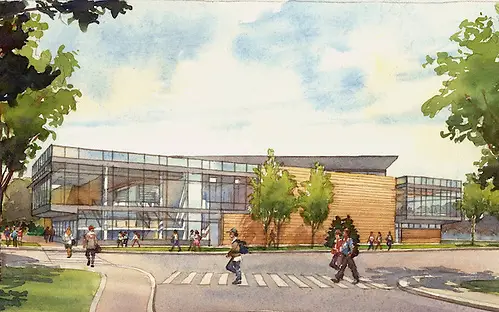
Thursday’s announcement of a new, on-campus home for the Bentley Falcons sent ripples through the college hockey universe. While fans, supporters and alumni rejoiced at the revelation of the multi-purpose arena housing the long-awaited hockey rink, other fans marveled at a small school making a bid to leave behind the sport’s proletariat to join the surrounding aristocracy.
The groundswell of congratulations and support for the move included Atlantic Hockey’s front offices on Massachusetts’ north shore.
“We are incredibly excited about the commitment from Bentley to hockey,” said commissioner Bob DeGregorio. “First, they committed to play Division I hockey [back in 1999], and now they’re making a commitment to make this program a truly great program.”
It’s a watershed moment for the conference. Since chartering for the 1998-99 season as the Metro Atlantic Athletic Conference, Atlantic Hockey has undergone numerous facelifts and landscape changes.
Of the eight teams that competed in that first year, only four (Holy Cross, Canisius, American International and Sacred Heart) are still in the league. At 11 teams following the departure of Connecticut in 2014, this could stand as a turning point where the league began to shore up its future.
“We have been around for 15 years, but the majority of our programs are some of the younger programs in hockey,” said DeGregorio. “As a league, we developed our strategic plan and part of that was to look at facilities of these teams. We’re seeing the commitment to new ones, with Bentley now joining RIT and Canisius, but we’re also looking at the ongoing improvement of some of the current ones. Whether it’s new lighting or new video boards or improving seating, this is part of the ongoing process of the league and its directors.
“We’re going to continue to get stronger and better [as a conference],” he said. “Overall, we’re moving in the right direction. We’re getting better with more scholarships, with new facilities and with the renovation and updates to our current arenas. The commitment is there. We’re going to remain the youngest dog in the fight compared to the older programs in the other leagues, but [days like this] will help us to keep working toward the goal of winning more games and creating more opportunity.”
One of the factors helping the institutions in their upgrades is a groundswell of support. RIT’s former barn at Ritter Arena was arguably one of the best home-ice advantages in college hockey, culminating with the team’s trip to the NCAA tournament and Frozen Four in 2010. Just over a year later, the school announced plans for the Polisseni Center.
At Bentley, growing support is one of the more noticeable byproducts of the program’s success over the past few years. The team played and won games at both Fenway Park in Boston and the Barclays Center in Brooklyn, N.Y., sent 17 fan buses to Harvard for a road game, and sold out John A. Ryan Arena, their home since 1977, for the first time last season against the eventual Hockey East champion Northeastern Huskies.
“I can’t speak for RIT,” said DeGregorio, “but I believe their drive was supported by the fans on campus. Hockey is not an inexpensive sport. You can build a gym for a lot cheaper than you can a rink when you factor in making ice, Zambonis and refrigeration.
“It’s a major commitment,” he continued. “Renovation and upgrades are a major commitment. So I’m very thankful that our schools are making this commitment. It’s great to see, and this is the icing on the cake for a world-class institution [like Bentley].”


